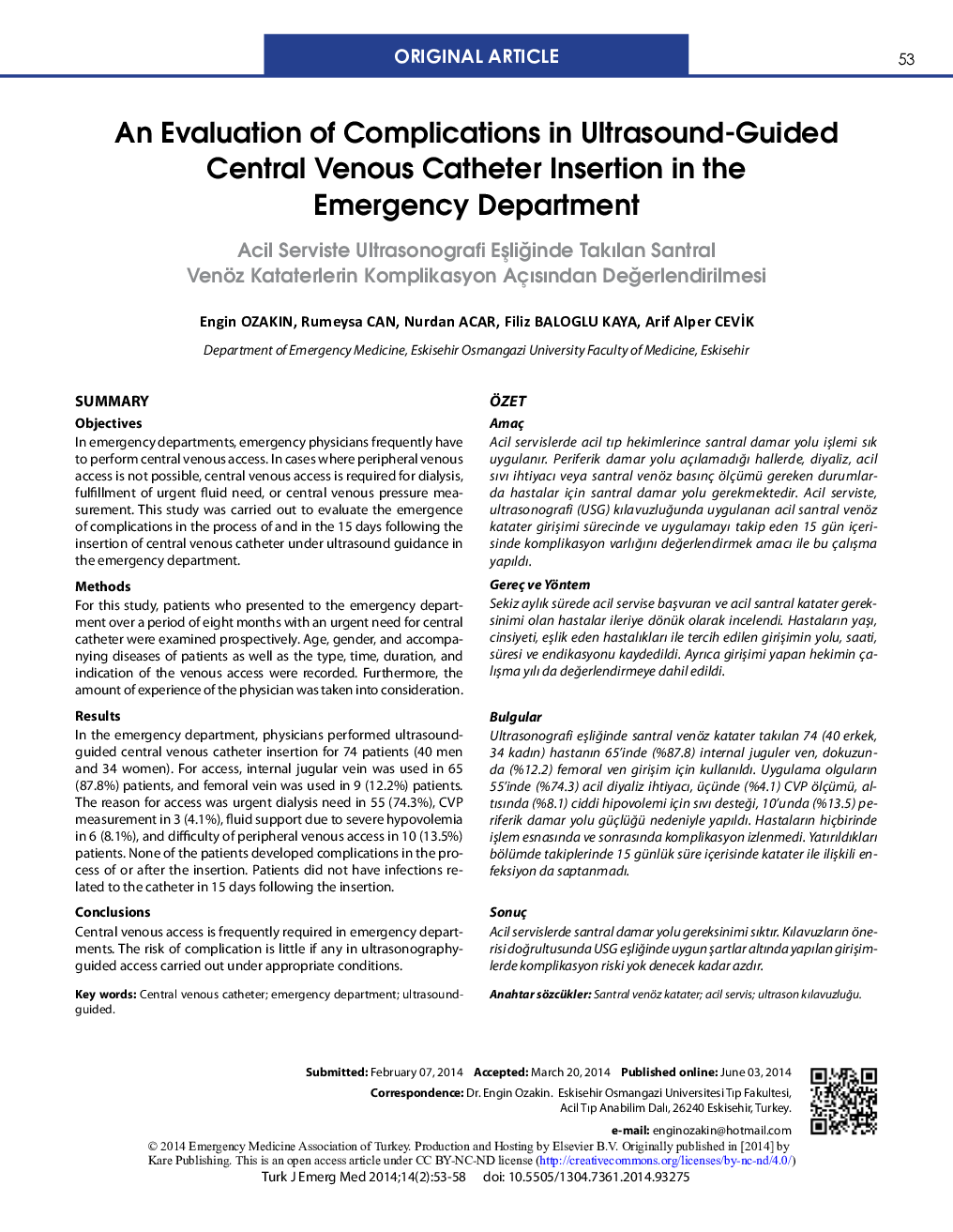| Article ID | Journal | Published Year | Pages | File Type |
|---|---|---|---|---|
| 2604169 | Turkish Journal of Emergency Medicine | 2014 | 6 Pages |
SUMMARYObjectivesIn emergency departments, emergency physicians frequently have to perform central venous access. In cases where peripheral venous access is not possible, central venous access is required for dialysis, fulfillment of urgent fluid need, or central venous pressure measurement. This study was carried out to evaluate the emergence of complications in the process of and in the 15 days following the insertion of central venous catheter under ultrasound guidance in the emergency department.MethodsFor this study, patients who presented to the emergency department over a period of eight months with an urgent need for central catheter were examined prospectively. Age, gender, and accompanying diseases of patients as well as the type, time, duration, and indication of the venous access were recorded. Furthermore, the amount of experience of the physician was taken into consideration.ResultsIn the emergency department, physicians performed ultrasound-guided central venous catheter insertion for 74 patients (40 men and 34 women). For access, internal jugular vein was used in 65 (87.8%) patients, and femoral vein was used in 9 (12.2%) patients. The reason for access was urgent dialysis need in 55 (74.3%), CVP measurement in 3 (4.1%), fluid support due to severe hypovolemia in 6 (8.1%), and difficulty of peripheral venous access in 10 (13.5%) patients. None of the patients developed complications in the process of or after the insertion. Patients did not have infections related to the catheter in 15 days following the insertion.ConclusionsCentral venous access is frequently required in emergency departments. The risk of complication is little if any in ultrasonographyguided access carried out under appropriate conditions.
ÖZETAmaçAcil servislerde acil tıp hekimlerince santral damar yolu işlemi sık uygulanır. Periferik damar yolu açılamadığı hallerde, diyaliz, acil sıvı ihtiyacı veya santral venöz basınç ölçümü gereken durumlarda hastalar için santral damar yolu gerekmektedir. Acil serviste, ultrasonografi (USG) kılavuzluğunda uygulanan acil santral venöz katater girişimi sürecinde ve uygulamayı takip eden 15 gün içerisinde komplikasyon varlığını değerlendirmek amacı ile bu çalışma yapıldı.Gereç ve YöntemSekiz aylık sürede acil servise başvuran ve acil santral katater gereksinimi olan hastalar ileriye dönük olarak incelendi. Hastaların yaşı, cinsiyeti, eşlik eden hastalıkları ile tercih edilen girişimin yolu, saati, süresi ve endikasyonu kaydedildi. Ayrıca girişimi yapan hekimin çalışma yılı da değerlendirmeye dahil edildi.BulgularUltrasonografi eşliğinde santral venöz katater takılan 74 (40 erkek, 34 kadın) hastanın 65'inde (%87.8) internal juguler ven, dokuzunda (%12.2) femoral ven girişim için kullanıldı. Uygulama olguların 55'inde (%74.3) acil diyaliz ihtiyacı, üçünde (%4.1) CVP ölçümü, altısında (%8.1) ciddi hipovolemi için sıvı desteği, 10'unda (%13.5) periferik damar yolu güçlüğü nedeniyle yapıldı. Hastaların hiçbirinde işlem esnasında ve sonrasında komplikasyon izlenmedi. Yatırıldıkları bölümde takiplerinde 15 günlük süre içerisinde katater ile ilişkili enfeksiyon da saptanmadı.SonuçAcil servislerde santral damar yolu gereksinimi sıktır. Kılavuzların önerisi doğrultusunda USG eşliğinde uygun şartlar altında yapılan girişimlerde komplikasyon riski yok denecek kadar azdır.
